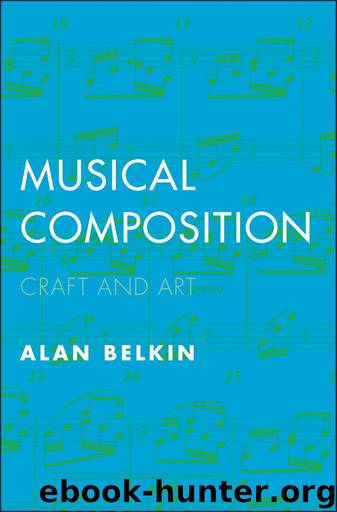Musical Composition: Craft and Art by Belkin Alan

Author:Belkin, Alan
Language: eng
Format: epub
Publisher: Yale University Press
Published: 2018-06-18T16:00:00+00:00
Figure 12.7. Thematic material in the first movement of Brahms, Symphony No. 2
Theme a begins the symphony. In D major, it has two components: the neighbor-note figure in the low strings, and then the four-bar phrase, appearing first in the horns and then in the winds.
The music arrives at a dominant pedal in measure 14, modulating to A major, in which key idea b arrives at measure 19. This idea picks up the neighbor-note figure that started theme a, extending it and giving it a new rhythmic profile, suggesting a kind of hemiola: despite the triple meter, this motive is grouped in twos. This is a beautiful example of counterpoint knitting together two ideas, as the strings and winds overlap with different rhythmic profiles. A held E (dominant of the coming key, A major) in the strings starts in measure 17. As the winds reach a peak on a high E in measure 19, the strings take up the same note, now in the same register as the winds, and begin to sing idea b. The overlapping winds slow down to end their phrase several bars later. This arrangement has the effect of shifting the listener’s focus at a key moment—a high point of the phrase—to something new, while the overlap smoothes over any possible discontinuity.
Then motive b descends gradually in the strings, reaching a stop in measure 31, but without a harmonic cadence. In measures 32–43, Brahms alternates between neutral low brass chords and the high winds, who return to the neighbor-note motive already heard in the fourth bar of theme a and in the second measure of b.
In measure 44 theme c arrives, in the violins. It also begins with a neighbor-note motive, but in a new rhythm. The last statement of the winds before this new idea (mm. 42–43) prepares the exact same pitches that begin it: A, G♯, A. The accompaniment to theme c in measure 44 is new: a gentle eighth-note tremolo figure in the lower strings.
Starting in measure 54, the new idea (c) takes on a more agitated character, allowing the gentle accompaniment figure to become more vigorous. It becomes staccato in measure 59, producing figure d. The orchestra now presents motive d in counterpoint with the original quarter-note neighbor figure from theme a.
In measure 66, the neighbor-note idea adopts the staccato eighth-note rhythm from d, giving us motive e. This in turn proposes a dialogue with a legato version of theme d. The activity calms down in measures 78–81, which harmonically prepare the new key, F♯ minor, while bringing back the hemiola idea mentioned above. Then, in measure 82, the new theme f arrives in the new key, accompanied by the legato version of motive d.
Once again, we can see how, whenever Brahms adds novelty, he also recalls something familiar. Before the two most important new ideas arrive (in mm. 44 and 82), he also creates harmonic tension, so that the new idea provides a sense of resolution. Thus, he reframes the new material in a way that makes it seem natural, even inevitable.
Download
This site does not store any files on its server. We only index and link to content provided by other sites. Please contact the content providers to delete copyright contents if any and email us, we'll remove relevant links or contents immediately.
Apple Pro Training Series: Logic Pro X: Professional Music Production by David Nahmani(439)
Mixing with Impact by Wessel Oltheten(303)
Musical Composition: Craft and Art by Belkin Alan(252)
Music and the Skillful Listener by Denise Von Glahn(191)
